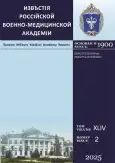Diagnosis of primary omental infarction and epiploic appendagitis using computed tomography
- 作者: Ryazanov V.V.1, Sadykova G.K.1, Kutsenko V.P.1, Zaika O.A.1, Gafiatulin M.R.1,2
-
隶属关系:
- Military Saint Petersburg State Pediatric Medical University
- North-Western State Medical University named after I.I. Mechnikov
- 期: 卷 44, 编号 2 (2025)
- 页面: 229-236
- 栏目: Discussion
- URL: https://journals.eco-vector.com/RMMArep/article/view/678059
- DOI: https://doi.org/10.17816/rmmar678059
- EDN: https://elibrary.ru/CTDQLI
- ID: 678059
如何引用文章
详细
Omental infarction and epiploic appendagitis are rare conditions characterized by fat tissue necrosis and clinically presenting with acute abdominal pain. Omental infarction and epiploic appendagitis can mimic various acute urological, surgical, and obstetric-gynecological diseases depending on pain localization. These conditions can be classified as primary or secondary, i.e. those of unknown origin or those resulting from a definite cause. It is generally believed that primary appendagitis is more common than primary omental infarction. Currently, there is no evidence-based consensus on the most optimal treatment approach for omental infarction and epiploic appendagitis. However, most experts agree that these conditions are self-limiting and tend to resolve spontaneously. Consequently, accurate detection and differentiation from other acute abdominal conditions requiring urgent surgery are crucial. For omental infarction and epiploic appendagitis, computed tomography remains the primary imaging modality in emergency diagnostics, as it is superior to clinical examination and blood chemistry in terms of sensitivity and specificity. The article reviews predisposing factors and anatomical prerequisites for primary omental infarction and epiploic appendagitis. It also details characteristic computed tomography signs that may be used to differentiate omental infarction and epiploic appendagitis between each other and from other acute abdominal conditions. Although computed tomography may identify typical signs of these conditions, the differentiation between primary omental infarction and epiploic appendagitis can sometimes be challenging. Therefore, the term “intra-abdominal focal fat infarction” is recommended.
全文:
作者简介
Vladimir Ryazanov
Military Saint Petersburg State Pediatric Medical University
Email: 79219501454@yandex.ru
ORCID iD: 0000-0002-0037-2854
SPIN 代码: 2794-6820
MD, Dr. Sci. (Medicine), Professor, Department of Modern Diagnostic Methods and Radiotherapy named after Professor S. A. Reinberg
俄罗斯联邦, 2 Litovskaya st., Saint Petersburg, 194100Gulnaz Sadykova
Military Saint Petersburg State Pediatric Medical University
Email: kokonya1980@mail.ru
ORCID iD: 0000-0002-6791-518X
SPIN 代码: 3115-7430
MD, Dr. Sci. (Medicine), Department of Modern Diagnostic Methods and Radiotherapy named after Professor S. A. Reinberg
俄罗斯联邦, 2 Litovskaya st., Saint Petersburg, 194100Valery Kutsenko
Military Saint Petersburg State Pediatric Medical University
Email: val9126@mail.ru
ORCID iD: 0000-0001-9755-1906
SPIN 代码: 5760-0218
MD, Dr. Sci. (Medicine), Department of Modern Diagnostic Methods and Radiotherapy named after Professor S. A. Reinberg
俄罗斯联邦, 2 Litovskaya st., Saint Petersburg, 194100Olesya Zaika
Military Saint Petersburg State Pediatric Medical University
Email: olesyazaika2001@mail.ru
ORCID iD: 0009-0009-6834-1155
resident, Department of Modern Diagnostic Methods and Radiotherapy named after Professor S. A. Reinberg
俄罗斯联邦, 2 Litovskaya st., Saint Petersburg, 194100Marat Gafiatulin
Military Saint Petersburg State Pediatric Medical University; North-Western State Medical University named after I.I. Mechnikov
编辑信件的主要联系方式.
Email: Gafiatulin_2000@mail.ru
ORCID iD: 0000-0002-5224-1717
SPIN 代码: 5832-4224
Postgraduate student of the Department of Human Morphology
俄罗斯联邦, 2, Litovskaya st., Saint Petersburg, 194100; 41, Kirochnaya str., Saint Petersburg, 191015参考
- Almeida AT, Melão L, Viamonte B, et al. Epiploic Appendagitis: An Entity Frequently Unknown to Clinicians — Diagnostic Imaging, Pitfalls, and Look-Alikes. AJR Am J Roentgenol. 2009;193(5):1243–1251. doi: 10.2214/AJR.08.2071
- Öztaş M, Türkoğlu B, Öztas B, et al. Rare causes of acute abdomen and review of literature: Primary/secondary omental torsion, isolated segmental omental necrosis, and epiploic appendagitis. Ulus Travma Acil Cerrahi Derg. 2023;29(2):193–202. doi: 10.14744/tjtes.2022.28430
- Thornton E, Mendiratta-Lala M, Siewert B, Eisenberg RL. Patterns of Fat Stranding. AJR Am J Roentgenol. 2011;197(1):W1–W14. doi: 10.2214/AJR.10.4375
- Babu M, Avantsa R. Multidetector Computed Tomography Evaluation of Omental Infarct. Journal of Gastrointestinal and Abdominal Radiology ISGAR. 2020;3(suppl S1):S1–S6. doi: 10.1055/s-0039-3402631
- Saad E, Awadelkarim A, Agab M, et al. Omental Fat Torsion: A Rare Mimicker of a Common Condition. J Investig Med High Impact Case Rep. 2022;10:23247096221076271. doi: 10.1177/23247096221076271
- Kerem M, Bedirli A, Mentes BB, et al. Torsion of the Greater Omentum: Preoperative Computed Tomographic Diagnosis and Therapeutic Laparoscopy. JSLS. 2005;9(4):494–496. PMID: 16381377
- Timofeev ME, Krechetova AP, Fedorov ED, Shapoval’iants SG. The clinical presentation, diagnostics and treatment of pathological changes of the epiploic appendices. Khirurgiya. Zurnal im. N.I. Pirogova. 2013;(10):77–83. EDN: RTOZXV
- Silvestruk SV. Torsion and necrosis of the fatty suspensions of the colon and strands of the greater omentum. Bulletin of medical Internet conferences (ISSN2224–6150). 2020;10(12):319–322. (In Russ.) Available at: https://medconfer.com/files/archive/2020-12/2020-12-24-A-19293.pdf
- Klimov AV, Solovyov IA, Avanesyan RG, et al. Mucocele of the appendix complicated by intussusception. Vestnik khirurgii im. I.I. Grekova. 2024;183(1):47–53. doi: 10.24884/0042-4625-2024-183-1-47-53 EDN: TZYQYS
- Kashchenko VA, Dzhemilova ZN, Zavrazhnov AA, et al. Prospects of qualitative and quantitative assessment of bowel perfusion by fluorescent angiography with indocyanine green in colorectal surgery. First experience. Khirurgiya. Zurnal im. N.I. Pirogova. 2024;(4):82–92. doi: 10.17116/hirurgia202404182 EDN: PFHXSZ
- Karelina NR, Gafiatulin MR, Oppedizano MDL, et al. Anatomy and functional anatomy of the large omentum. Forcipe. 2023;6(4):36–53. EDN: GGHLPM
- Ghahremani GG, White EM, Hoff FL, et al. Appendices epiploicae of the colon: radiologic and pathologic features. Radiographics. 1992;12(1)59–77. doi: 10.1148/radiographics.12.1.1734482
补充文件














